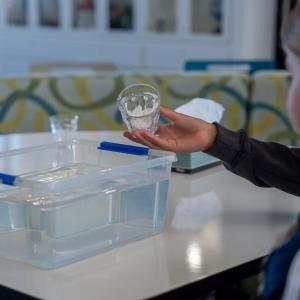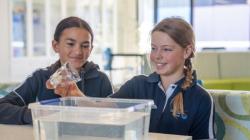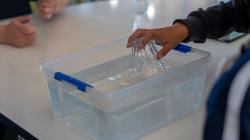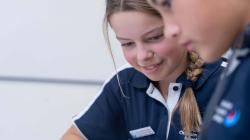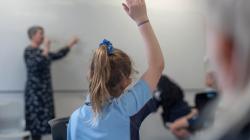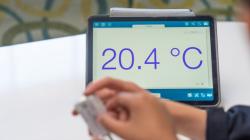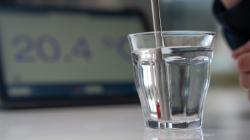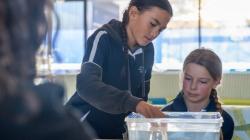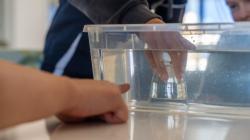'Communicating matters' is one of our new teaching sequences for AC V9
- On the 'Sequence overview' tab you'll find all the lessons in this sequence and curriculum alignment.
- The 'Our design decisions' tab shows how key scientific ideas develop over the sequence, and shows how the sequence addresses curriculum achievement standards.
- The 'Preparing for this sequence' tab guides you through important information and considerations for this sequence.
- Have you taught this sequence? Use the Feedback button to let us know how it went!
Launch
Lesson 1 • Solid, liquid or gas?
This lesson introduces the context and content of this teaching sequence: exploring solids, liquids and gases, the scientific theory that explains their behaviour (the particle model), and the substances that are sometimes difficult to categorise.
Inquire
Lesson 2 • What is a liquid?
Students undertake a hands-on exploration to determine the properties of a liquid.
Lesson 3 • Searching for solids
Students undertake a hands-on exploration to determine the properties of a solid.
Lesson 4 • What a gas
Students undertake a hands-on exploration to determine the properties of a gas.
Lesson 5 • Hot air
Students plan and conduct a fair test investigation to determine if the observable properties of a gas change with an increase in temperature.
Lesson 6 • Playing particles
Students participate in a role-play to explore the arrangement of particles in solids, liquids and gases (the particle model).
Lesson 7 • Questioning communicators
Students prepare to undertake the role of science communicators by re-examining substances, considering what questions their audience might ask about them, and preparing possible responses and further questions to ask.
Act
Lesson 8 • Communicating science ideas
Students consolidate their learning by creating a text to communicate the science ideas they have learned.
The Australian Academy of Science supports and encourages broad use of its material. Unless indicated below, copyright material available on this website is licensed under a Creative Commons Attribution-NonCommercial-ShareAlike 4.0 International (CC BY-NC-SA 4.0) licence.
Curriculum and syllabus alignment
Achievement standards
By the end of Year 5 students relate the particulate arrangement of solids, liquids and gases to their observable properties. They describe examples of collaboration leading to advances in science, and scientific knowledge that has changed over time. They identify examples where scientific knowledge informs the actions of individuals and communities.
Students plan safe investigations to identify patterns and relationships and make reasoned predictions. They identify risks associated with investigations and key intercultural considerations when planning field work. They identify variables to be changed and measured. They use equipment to generate data with appropriate precision. They construct representations to organise data and information and describe patterns, trends and relationships. They compare their methods and findings to those of others, identify possible sources of error in their investigation, pose questions for further investigation and draw reasoned conclusions. They use language features that reflect their purpose and audience when communicating their ideas and findings.
Australian Curriculum V9 alignment
Science as a human endeavour
Science understanding
Explain observable properties of solids, liquids and gases by modelling the motion and arrangement of particles
Science inquiry
Pose investigable questions to identify patterns and test relationships and make reasoned predictions
Plan and conduct repeatable investigations to answer questions, including, as appropriate, deciding the variables to be changed, measured and controlled in fair tests; describing potential risks; planning for the safe use of equipment and materials; and identifying required permissions to conduct investigations on Country/Place
Use equipment to observe, measure and record data with reasonable precision, using digital tools as appropriate
Construct and use appropriate representations, including tables, graphs and visual or physical models, to organise and process data and information and describe patterns, trends and relationships
Compare methods and findings with those of others, recognise possible sources of error, pose questions for further investigation and select evidence to draw reasoned conclusions
Write and create texts to communicate ideas and findings for specific purposes and audiences, including selection of language features, using digital tools as appropriate
Australian curriculum content links
| Science understanding core concept: The physical properties of substances are determined by their structure at a range of scales. |
| Sub-strand | Content descriptor | AC code | Achievement Standard | How the sequence addresses this content |
| SHE: Nature and development of science | Examine why advances in science are often the result of collaboration or build on the work of others. | AC9S5H01 | Describe examples of collaboration leading to advances in science, and scientific knowledge that has changed over time. | Build on their previous work identifying the properties of gases by investigating to consider if these properties can be changed, and if temperature affects them. (Lesson 5) |
| SHE: Use and influence of science | Investigate how scientific knowledge is used by individuals and communities to identify problems, consider responses and make decisions. | AC9S5H02 | Identify examples where scientific knowledge informs the actions of individuals and communities. | Explore real-life examples by identifying what happens when heating and cooling gases. (Lesson 5) |
| SU: Chemical sciences | Explain observable properties of solids, liquids and gases by modelling the motion and arrangement of particles. | AC9S5U04 | Relate the particulate arrangement of solids, liquids and gases to their observable properties. | Investigate to explore and name the properties of solids, liquids and gases. (Lessons 2, 3, 4 and 5) Role-play particles arrangements in solids, liquids and gases (Lesson 6), and consider what the arrangement of particles looks like in substances such as oobleck, sponges and soft drink. (Lessons 7, 8) |
| SI: Questioning and predicting | Pose investigable questions to identify patterns and test relationships and make reasoned predictions. | AC9S5I01 | Plan safe investigations to identify patterns and relationships and make reasoned predictions. | Plan exploratory and fair-test investigation (Lessons 2, 3, 4, 5), with reference to safety (Lesson 5). They make predictions about the outcomes of investigations.(Lessons 2, 3, 4, 5) |
SI: Planning and conducting
| Plan and conduct repeatable investigations to answer questions, including, as appropriate, deciding the variables to be changed, measured and controlled in fair tests; describing potential risks; planning for the safe use of equipment and materials; and identifying required permissions to conduct investigations on Country/Place. | AC9S5I02 | Identify risks associated with investigations and key intercultural considerations when planning field work. They identify variables to be changed and measured. | Plan and conduct a fair-test investigation to answer the question “What happens to air at different temperatures”, with reference to appropriate safety measures. (Lesson 5) |
| SI: Planning and conducting | Use equipment to observe, measure and record data with reasonable precision, using digital tools as appropriate. | AC9S5I03 | Use equipment to generate data with appropriate precision. | Observe and record the results of scientific investigations in using data tables, measurements, labelled diagrams, photographs and video. (Lessons 2, 3, 4, 5) |
| SI: Processing, modelling and analysing | Construct and use appropriate representations, including tables, graphs and visual or physical models, to organise and process data and information and describe patterns, trends and relationships. | AC9S5I04 | Construct representations to organise data and information and describe patterns, trends and relationships. | Record the results of scientific investigations in using data tables, measurements, labelled diagrams, photographs and video. (Lessons 2, 3, 4, 5) Develop models of the arrangement of particles in solids, liquids and gases through role-play and labelled diagrams and use them to articulate their thinking. (Lessons 6, 7, 8) |
| SI: Evaluating | Compare methods and findings with those of others, recognise possible sources of error, pose questions for further investigation and select evidence to draw reasoned conclusions. | AC9S5I05 | Compare their methods and findings to those of others, identify possible sources of error in their investigation, pose questions for further investigation and draw reasoned conclusions. | Share, compare and question findings of investigations, participating in discussion to reach consensus. (Lessons 2, 3, 4, 5, 6) |
| SI: Communicating | Write and create texts to communicate ideas and findings for specific purposes and audiences, including selection of language features, using digital tools as appropriate. | AC9S5I06 | Use language features that reflect their purpose and audience when communicating their ideas and findings. | Represent their understanding of the particle model through labelled diagrams. (Lesson 6) Use representation and modelling to articulate their thinking (Lessons 1, 6, 7, 8) Compose texts in multiple modalities to communicate science ideas. (Lessons 7, 8) |
Science journals
Create a class science journal, either in hard-copy or digitally. You might:
- use/create a large scrap book or flip chart.
- use poster/butchers’ paper so learning can be displayed in sequence on the wall.
- create a digital journal using your platform/ technology of choice.
- any combination of the above.
Plan for students’ creation of an individual science journal, either in hard-copy or digitally. They might:
- use an exercise book, scrap book or flip chart to record their thinking and gather resource sheets together.
- use a folder to store and collate resource sheets, diagrams, photographs etc.
- use a digital folder to store work samples, images and videos.
- any combination of the above.
See Using a science journal throughout inquiry for more detailed information on the importance of science journals.
Additional preparation
- Read through the teaching sequence.
- Note any adaptations you would like to make to suit your school’s and students’ context.
- Consider the audience you select for students to communicate with.
- It may not be appropriate to select a younger year level, as developmentally the concepts covered are not appropriate. It also diminishes the repeatability of the sequence, as students in younger year levels will have already ‘learned’ (albeit in a non-experiential way) about the concepts.
- Presenting to an older audience, for example, Year 6, will allow the Year 5 students to not only receive feedback on their science communication skills, but also on the accuracy of their information given that the Year 6 students would have learnt about the concepts the previous year.
- You might also consider asking students to communicate with a parent audience as part of an ‘open-day’ or ‘science-fair’ type experience.
- Consider if you might integrate the sequence with learning in English regarding composing texts.
- Throughout this sequence students are required to examine a number of samples of solids and liquids. You might present these to students in small transparent containers. Some suggestions of samples you might like to prepare are:
- solids that are easily identifiable: rocks/stones, wood, plastic, and metal etc.
- solids that are not as easily identifiable: playdough (a soft solid), paper (a flexible solid), elastic bands (a stretchy solid), or a sponge (a solid interspersed with pockets of gas/air).
- pourable solids: washing powder, sugar, salt, flour etc.
- liquids: water, oil, honey, soft-drink etc.
The materials required for each lesson are listed on the lesson's page. For the full sequence resource list, download the Preparing to teach this sequence document below.
